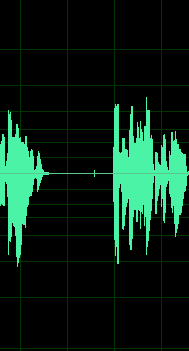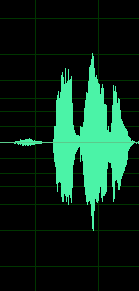Voice work ebbs and flows. All freelancers and self-employed people go through this with their work. There are times when you feel like you’re standing in front of a tidal wave. Other times, you crank the tap and only a trickle comes out!
As long as there’s enough water when you need it, no complaints.
Derek sometimes has many jobs with competing deadlines piling on top of each other and the only way he can get them done is if I edit the audio files so he can keep narrating. It occurred to me that, if you’re in a completely different line of work, “editing audio files” might not mean much to you. So, today, I thought I’d offer a peek into what that entails.
I’m far from new to editing. I date back to the Jurassic era when a grease pencil and reel-to-reel tape were the pinnacle of technology. Editing a terrific listener phone call to take out the one F bomb they threw, so you can play it on the air when this song ends in less than a minute – that’s editing, my friend!
Of course, it’s much easier now that everything’s digital. These are highlights, some of the more easily explained aspects of audio editing, and by no means is this a tutorial. I run filters, remove things and do other processing that I won’t get into here. But this will give you an idea.

This is what a voice file looks like, in general terms. The long, green spikes that span the whole screen are marks that Derek makes to denote a “pickup”. That’s a place where he has made a mistake, or doesn’t like the way he read something. He makes a clicking sound that creates the spike so I know where the error is. Then he reads the line again. I zoom into those places and remove the mistake. Voila – perfection!

A lot of what we do to clean up audio is to remove what we call, “cat food”. That’s mouth noises that you don’t want in your finished file. If I left that small green line in the file above, it would annoy and distract the listener. That’s what a lip smack looks like.
And this little bump ahead of the spoken words, is an intake of breath:

De-breathing is important for commercials, corporate videos and the like. If the voice artist stops for a breath mid-sentence, it’s up to the editor to make the sentence flow and sound natural. That might mean adding some silence or editing the words tightly together – it’s different in every case.
In audiobooks, it’s different again. The pace is generally slower (longer spaces between sentences) and some breathing is left in. Research shows that if there’s no breathing, the listener gets uncomfortable. The narrator is speaking for so long that it’s natural to hear a bit of breath. But it can’t be too loud or too sharp.
And just to throw a spanner into the works, this is the screen I actually look at while I’m editing audio. Some stay in the waveform view when they edit. I like spectral view. It took a while to learn it but now that I have, I’m a convert.

It always seems to work out that I’m not as busy with my own work when Derek finds himself under an avalanche and needs me to edit. It’s a nice change of pace and I find satisfaction in it. Sometimes it’s so boring I could bang my head against the foam covered wall of my studio! But every bit of spoken word we produce is important to someone, and they’re willing to pay us to do it, so that makes it important to us.


Very nice piece Lisa. As someone who spent 30 years editing audio for radio I know the satisfaction of turning a piece of audio full of umms and uhhs and various other blemishes into something tight and smooth as glass. And yes, I too go back to the days of the grease pencil, razor and splicing tape. I’d love to say I miss those times, but I can’t.
I have noticed that you rarely hear an intake of breath during a commercial. Now I have a wee bit of knowledge about how this is accomplished. Thanks for explaining how this is done. Now, if you could only edit people to stop saying “like” in every sentence. I guess it’s the new word used instead of um or ah (which seems to be the word that Justin Trudeau uses all the time.) Like, wow!
Oh, so that’s what you see! As someone who once trained as a sound engineer, I’m familiar with the old grease pencil, razor and splicing tape and now occasionally perform audio editing on MP3 files for friends but in both cases I’ve performed the editing based on what I hear, not what I see. I understand the different colours representing the various tracks and the peaks and spikes but nobody has ever describe it to me. Thanks. Strike that off my C bucket list.
I wish the CBC radio would de-breath some of their voice artists. One in particular comes to mind that sounds like the mic is in her throat. It’s very annoying.
It’s usually just bad mic technique. Jian Ghomeshi used to be the worst for it and I always wondered why no one said anything to him. It’s so easy to fix!